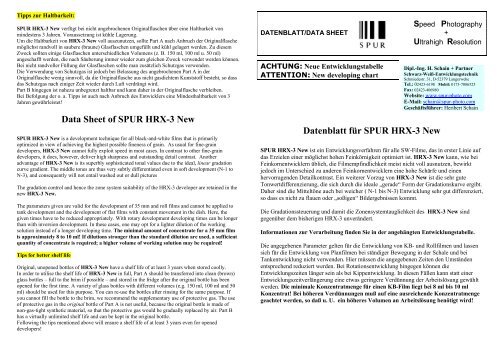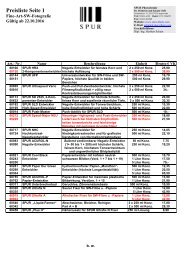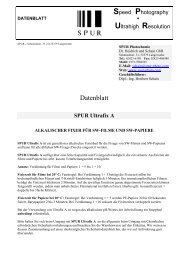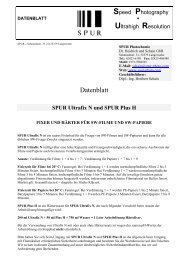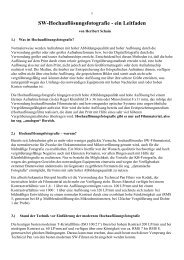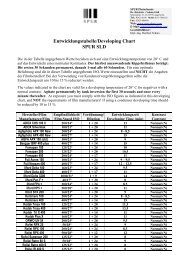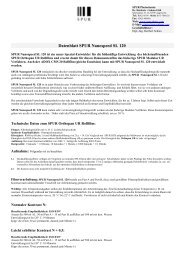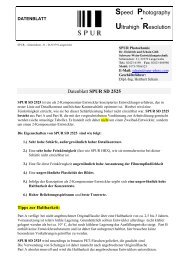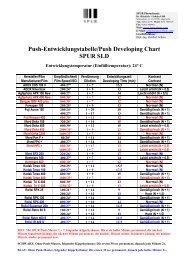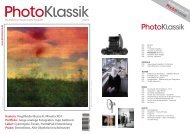Erfolgreiche ePaper selbst erstellen
Machen Sie aus Ihren PDF Publikationen ein blätterbares Flipbook mit unserer einzigartigen Google optimierten e-Paper Software.
Tipps zur Haltbarkeit:<br />
<strong>SPUR</strong> <strong>HRX</strong>-3 <strong>New</strong> verfügt bei nicht angebrochenen Originalflaschen über eine Haltbarkeit von<br />
mindestens 3 Jahren. Voraussetzung ist kühle Lagerung.<br />
Um die Haltbarkeit von <strong>HRX</strong>-3 <strong>New</strong> voll auszunutzen, sollte Part A nach Anbruch der Originalflasche<br />
möglichst randvoll in saubere (braune) Glasflaschen umgefüllt und kühl gelagert werden. Zu diesem<br />
Zweck sollten einige Glasflaschen unterschiedlichen Volumens (z. B. 150 ml, 100 ml u. 50 ml)<br />
angeschafft werden, die nach Säuberung immer wieder zum gleichen Zweck verwendet werden können.<br />
Bei nicht randvoller Füllung der Glasflaschen sollte man zusätzlich Schutzgas verwenden.<br />
Die Verwendung von Schutzgas ist jedoch bei Belassung des angebrochenen Part A in der<br />
Originalflasche wenig sinnvoll, da die Originalflasche aus nicht gasdichtem Kunstst<strong>of</strong>f besteht, so dass<br />
das Schutzgas nach einiger Zeit wieder durch Luft verdrängt wird.<br />
Part B hingegen ist nahezu unbegrenzt haltbar und kann daher in der Originalflasche verbleiben.<br />
Bei Befolgung der o. a. Tipps ist auch nach Anbruch des Entwicklers eine Mindesthaltbarkeit von 3<br />
Jahren gewährleistet!<br />
<strong>Data</strong> <strong>Sheet</strong> <strong>of</strong> <strong>SPUR</strong> <strong>HRX</strong>-3 <strong>New</strong><br />
<strong>SPUR</strong> <strong>HRX</strong>-3 <strong>New</strong> is a development technique for all black-and-white films that is primarily<br />
optimized in view <strong>of</strong> achieving the highest possible fineness <strong>of</strong> grain. As usual for fine-grain<br />
developers, <strong>HRX</strong>-3 <strong>New</strong> cannot fully exploit speed in most cases. In contrast to other fine-grain<br />
developers, it does, however, deliver high sharpness and outstanding detail contrast. Another<br />
advantage <strong>of</strong> <strong>HRX</strong>-3 <strong>New</strong> is its superbly sophisticated tonal values due to the ideal, linear gradation<br />
curve gradient. The middle tones are thus very subtly differentiated even in s<strong>of</strong>t development (N-1 to<br />
N-3), and consequently will not entail washed out or dull pictures<br />
The gradation control and hence the zone system suitability <strong>of</strong> the <strong>HRX</strong>-3 developer are retained in the<br />
new <strong>HRX</strong>-3 <strong>New</strong>.<br />
The parameters given are valid for the development <strong>of</strong> 35 mm and roll films and cannot be applied to<br />
tank development and the development <strong>of</strong> flat films with constant movement in the dish. Here, the<br />
given times have to be reduced appropriately. With rotary development developing times can be longer<br />
than with inversion development. In these cases, one may opt for a lighter dilution <strong>of</strong> the working<br />
solution instead <strong>of</strong> a longer developing time. The minimal amount <strong>of</strong> concentrate for a 35 mm film<br />
is approximately 8 to 10 ml! If dilutions stronger than the standard dilution are used, a sufficient<br />
quantity <strong>of</strong> concentrate is required; a higher volume <strong>of</strong> working solution may be required!<br />
Tips for better shelf life<br />
Original, unopened bottles <strong>of</strong> <strong>HRX</strong>-3 <strong>New</strong> have a shelf life <strong>of</strong> at least 3 years when stored coolly.<br />
In order to utilise the shelf life <strong>of</strong> <strong>HRX</strong>-3 <strong>New</strong> in full, Part A should be transferred into clean (brown)<br />
glass bottles – full to the brim if possible – and stored in the fridge after the original bottle has been<br />
opened for the first time. A variety <strong>of</strong> glass bottles with different volumes (e.g. 150 ml, 100 ml and 50<br />
ml) should be used for this purpose. You can re-use the bottles after rinsing for the same purpose. If<br />
you cannot fill the bottle to the brim, we recommend the supplementary use <strong>of</strong> protective gas. The use<br />
<strong>of</strong> protective gas in the original bottle <strong>of</strong> Part A is not useful, because the original bottle is made <strong>of</strong><br />
non-gas-tight synthetic material, so that the protective gas would be gradually replaced by air. Part B<br />
has a virtually unlimited shelf life and can be kept in the original bottle.<br />
Following the tips mentioned above will ensure a shelf life <strong>of</strong> at least 3 years even for opened<br />
developers!<br />
Speed Photography<br />
DATENBLATT/DATA SHEET +<br />
Ultrahigh Resolution<br />
ACHTUNG: Neue Entwicklungstabelle<br />
ATTENTION: <strong>New</strong> developing chart<br />
<strong>Datenblatt</strong> <strong>für</strong> <strong>SPUR</strong> <strong>HRX</strong>-3 <strong>New</strong><br />
Dipl.-Ing. H. Schain + Partner<br />
Schwarz-Weiß-Entwicklungstechnik<br />
Schmiedestr. 31, D-52379 Langerwehe<br />
Tel.: 02423-6198 Mobil: 0173-7086525<br />
Fax: 02423-406980<br />
Website: www.spur-photo.com<br />
E-Mail: schain@spur-photo.com<br />
Geschäftsführer: Heribert Schain<br />
<strong>SPUR</strong> <strong>HRX</strong>-3 <strong>New</strong> ist ein Entwicklungsverfahren <strong>für</strong> alle SW-Filme, das in erster Linie auf<br />
das Erzielen einer möglichst hohen Feinkörnigkeit optimiert ist. <strong>HRX</strong>-3 <strong>New</strong> kann, wie bei<br />
Feinkornentwicklern üblich, die Filmempfindlichkeit meist nicht voll ausnutzen, bewirkt<br />
jedoch im Unterschied zu anderen Feinkornentwicklern eine hohe Schärfe und einen<br />
hervorragenden Detailkontrast. Ein weiterer Vorzug von <strong>HRX</strong>-3 <strong>New</strong> ist die sehr gute<br />
Tonwertdifferenzierung, die sich durch die ideale „gerade“ Form der Gradationskurve ergibt.<br />
Daher sind die Mitteltöne auch bei weicher ( N-1 bis N-3) Entwicklung sehr gut differenziert,<br />
so dass es nicht zu flauen oder „soßigen“ Bildergebnissen kommt.<br />
Die Gradationssteuerung und damit die Zonensystemtauglichkeit des <strong>HRX</strong>-3 <strong>New</strong> sind<br />
gegenüber dem bisherigen <strong>HRX</strong>-3 unverändert.<br />
Informationen zur Verarbeitung finden Sie in der angehängten Entwicklungstabelle.<br />
Die angegebenen Parameter gelten <strong>für</strong> die Entwicklung von KB- und Rollfilmen und lassen<br />
sich <strong>für</strong> die Entwicklung von Planfilmen bei ständiger Bewegung in der Schale und bei<br />
Tankentwicklung nicht verwenden. Hier müssen die angegebenen Zeiten den Umständen<br />
entsprechend reduziert werden. Bei Rotationsentwicklung hingegen können die<br />
Entwicklungszeiten länger sein als bei Kippentwicklung. In diesen Fällen kann statt einer<br />
Entwicklungszeitverlängerung eine etwas geringere Verdünnung der Arbeitslösung gewählt<br />
werden. Die minimale Konzentratmenge <strong>für</strong> einen KB-Film liegt bei 8 ml bis 10 ml<br />
Konzentrat! Bei höheren Verdünnungen muß auf eine ausreichende Konzentratmenge<br />
geachtet werden, so daß u. U. ein höheres Volumen an Arbeitslösung benötigt wird!


